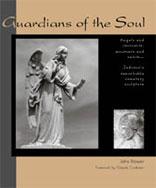 |
||
Guardians of the Soul: Angels and innocents, mourners and saints—Indiana's remarkable cemetery sculpture PHOTOGRAPHY by John Bower, FOREWORD by Claude Cookman |
||
|
||||
Motivation and inspiration for creating Guardians of the Soul While Lynn and I were exploring and photographing Southern Indiana for our first photography book, Lingering Spirit, we routinely found ourselves eating our packed lunches in a cemetery. While I’ve always found cemeteries to be serene garden-like places to wander through, I also slowly became aware of the extraordinary beauty of the aging statuary that can be found in them. To me, there was a quality, quantity, and variety of this three-dimensional art that is simply not being duplicated today. These special monuments, most of which are roughly 100 years old, were erected as lasting memorials to deeply loved individuals. I believe survivors felt that, with an exceptional carving above, those below would never be forgotten. Of course, over time, the survivors also died, and much of this sculpture slipped into obscurity. Today, few people even know that such statuary exists in their local cemeteries. Surprisingly, I found this was true even for many funeral directors. To me, this lack of awareness was tragic, especially as weathering, acid rain, and vandalism continue to take their toll. So, I created Guardians of the Soul to share what Lynn and I had—often quite unexpectedly—discovered in these quiet settings of final rest. People simply need to know about these hidden treasures, many of which would be at home in any art museum in the country. Guardians of the Soul is OUT-OF-PRINT and no longer available. |
||
The Journey... While Lynn and I were working on Lingering Spirit, we’d seen some amazing statuary in southern Indiana cemeteries, and knew they deserved to be honored. Once again, Lynn came up with a great title: Guardians of the Soul—Angels and innocents, mourners and saints—Indiana’s remarkable cemetery sculpture. There wasn’t enough cemetery statuary in the 10 counties we just covered in Lingering Spirit to fill a book, and searching the entire state sounded daunting, so we divided Indiana in half (at U.S. 40, the old National Road) and concentrated on Southern Indiana’s cemeteries. We began by making a list of the statues we’d already found, then contacted county historians, historical societies, libraries, even morticians—anyone who could supply us with leads. We ended up locating over 600 statues, in about 200 cemeteries, most of them true works of art, produced by highly skilled craftsmen. In cities like Indianapolis and Evansville, we found large cemeteries containing many sculptures. But we also visited scores of small, country graveyards with a single statue amid the worn slabs of marble, limestone, and granite. The magnificent angles—adult-sized, child versions, St. Michael the Archangel, fat cherubs—were our favorites. But the most poignant were the realistic likenesses of children, deeply loved and laid to rest before their time. Many were still regularly decorated with flowers—a century after the child’s passing. There was a boy with a baseball mitt and bat, another with his pet dog, a girl taking a step forward into eternity, another waiting at the gate for her daddy to come home for supper. Even those covered in lichen, or missing an arm or leg, were still touching reminders of how much the children were loved. The variety of statues we found was amazing: there were soldiers representing the Revolutionary War, Civil War, and both world wars; a priest wearing a lacy vestment, holding up a crucifix in blessing; a bronze bas relief of Indiana Governor Alvin P. Hovey, surrounded by laurel leaves; Demeter (goddess of harvest), atop four Corinthian columns, holding a scythe; a volunteer fireman, with a small child in his arms; master stone carver, Johnnie Casper, standing on top of a monument to the Bedford Stonecutters Association; an old man, dressed neatly in coat and tie, with a fedora on his head, and a billy-goat beard on his chin. There were also different styles of mourning women, and those gazing expectantly toward heaven. We found many carvings of doves and lambs on the graves of children, but other animals were less expected—three pairs of lions, several dogs, a cat, two swans, eagles. We even discovered two horses, almost life-size—one decorating the final resting place of a Civil War veteran of the Kentucky Cavalry, and a similar one, not 20 miles away, marking the grave of a horse lover. As our book neared completion, I was quite pleased when Claude Cookman agreed to write the Foreword. I’d met him through the Bloomington Photography Club, where he impressed me with his ability to read and interpret photographs. Claude shared in the Pulitzer Prize for Feature Photography when he worked at the Louisville Times, but now taught photography at the Indiana University Journalism School. With advanced degrees in Art History and the History of Photography (both from Princeton), he truly recognized the grandeur, significance, and importance of my subject matter, and he wrote a very insightful Foreword. |
||
